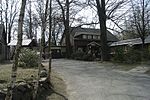Upper Lusatia

Upper Lusatia (German: Oberlausitz [ˈoːbɐˌlaʊzɪts] (listen); Upper Sorbian: Hornja Łužica ['hɔʀnʲa 'u̯uʒit͡sa]; Lower Sorbian: Górna Łužyca; Silesian: Gōrnŏ Łużyca; Polish: Łużyce Górne or Milsko; Czech: Horní Lužice) is a historical region in Germany and Poland. Along with Lower Lusatia to the north, it makes up the region of Lusatia, named after the Slavic Lusici tribe. Both parts of Lusatia are home to the West Slavic minority group of the Sorbs. The major part of Upper Lusatia is part of the German federal state of Saxony, roughly comprising Bautzen district and Görlitz district. The northwestern extremity, around Ruhland and Tettau, is incorporated into the Oberspreewald-Lausitz district of the state of Brandenburg. The eastern part of Upper Lusatia is in Poland, east of the Neisse (Nysa) river, in Lower Silesian Voivodeship. A small strip of land in the north around Łęknica is incorporated into Lubusz Voivodeship, along with the Polish part of Lower Lusatia. The historic capital of Upper Lusatia is Bautzen/Budyšin, while the largest city in the region is Görlitz/Zgorzelec, halved between Germany and Poland since 1945. The name Lusatia superior was first recorded in a 1474 deed, derived from the adjacent Lower Lusatian lands in the north, which originally were just called the March of Lusatia. The Upper Lusatian territory was previously referred to as Milsko in contemporary chronicles, named after the local West Slavic Milceni tribe, later also called Land Budissin.
Excerpt from the Wikipedia article Upper Lusatia (License: CC BY-SA 3.0, Authors, Images).Upper Lusatia
Rosengasse,
Geographical coordinates (GPS) Address Nearby Places Show on map
Geographical coordinates (GPS)
| Latitude | Longitude |
|---|---|
| N 51.167 ° | E 14.333 ° |
Address
Rosengasse
Rosengasse
02633
Saxony, Germany
Open on Google Maps











